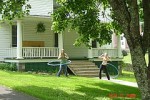Homemade Polymer Clay (that is not Polymer Clay)
 This picture, from Curbly, inspired me to look up homemade polymer clay recipes. There is debate on which is ‘better’ and from what I gather that depends on what you are trying to make. This appeals to my crafty, must-create-something tendencies.
This picture, from Curbly, inspired me to look up homemade polymer clay recipes. There is debate on which is ‘better’ and from what I gather that depends on what you are trying to make. This appeals to my crafty, must-create-something tendencies.
Recipes found include:
Cold Porcelain Clay:
- 1. Combine in a Teflon-coated pot:
1 cup polyvinyl acetate glue such as Elmer’s Glue All 1 cup cornstarch 2 tablespoons Vaseline oil (not jelly) – if unavailable where you live, substitute baby oil or pharmaceutical grade mineral oil 1 tablespoon lemon juice.
- 2. Cook on low heat stirring constantly for 10 minutes or until dough forms and begins to come away from the sides. If you have a gas stove, you may need to use a heat diffuser under the pot to avoid burning the dough.
- 3. Remove from heat and allow to cool until you can handle it.
- 4. Knead into a smooth clay consistency.
- 5. Store in a cool, dark place at noted in tips above.
- 6. Tempura powder or acrylic paints may be used for coloring the dough.
Hmm. I do not have vaseline oil – where do you find that? Ok, on to Victorian Salt clay; now these ingredients I do have:
Cornstarch modeling clays containing salt are the most porous, so are only suitable for craft projects that have a rough or rustic finish.
- 1. Mix 2 cups salt and 2/3 cup water in a pan.
- 2. Mix 1 cup cornstarch and 1/2 cup ice water in a bowl.
- 3. Stirring constantly, heat salt combination over a low flame for about 4 minutes. Do not boil. If you have a gas stove, you may need to use a heat diffuser under the pot to avoid burning the dough.
- 4. Remove from heat. Quickly stir in the cornstarch and water. If mixture is too thin, return to low heat and stir constantly until of clay consistency.
- 5. Store in a cool, dark place at noted in tips above.
- 6. Tempura powder or acrylic paints may be used for coloring the dough.
There is also a recipe for Pasta Francesa, which is very popular in Latin American countries – it includes formaldehyde as an optional ingredient. This link will take you to all three recipes.
Marie, of Art from my Heart, creates with ploymer clay – can you shed some light on this?
In other news, we are in blizzard conditions at the moment. Word has it that in the next county up, if you are on the road in anything other than a 4WD, you will be ticketed.
Stay warm!






~aahhh sweet…yet another fun thing to make with the little ones…you are just full of wonderful things to share…thank you so and a bright blessed day to you~
Thank you Faerwillow. =) If you can, post a picture of some of your and the chillin's creations. I'd love to see!
I had no idea you could make polymer clay at home. Neat o! Thanks for posting this :)Jen
ihave just discoverd accrylic polymer glue that makes the cold porcelain a bit like polymer clay
Oooh, I’ll have to check that out. Thank you for the heads up!
thank you very much it’s just we needed
thank you very much it’s just what we needed.
would you like photo og finial project
definitely forward a picture of the final project! =)
Hi there i want to make a homemade clay that would be damp resistant as its for a diorama in my lof and it can get cold and a little damp up there at times would this work or is there another recipie i can use to make a more water resistant clay? I would like to make the clay as i would want large amounts and shop brought would cost me a fortune to buy it. 😦
Hope someone can help
kind regards
Steve
Thanks for the article and recipe. I think you should clarify that this is NOT polymer clay and change the name of the recipe since ppl who are looking specifically for polymer clay may not read through the directions thoroughly and can miss that this shouldn’t be baked in the oven as polymer clay needs to be. There are many things you can do with this recipe, however, there are some things you cannot do with it that you can with polymer.
Thank you again for the recipe. It looks like it would be great to use for children and others who do not require the costly polymer clay.
BethD
Do you know where to get a polymer clay recipie?
Hey there BethD is right, this recipe is more like those which are labelled cold porcelain. It is great for detailed work. Best thing about it is it doesn’t need baking.!
Your method of telling everything in this piece of writing is genuinely
fastidious, all be able to simply know it, Thanks a lot.